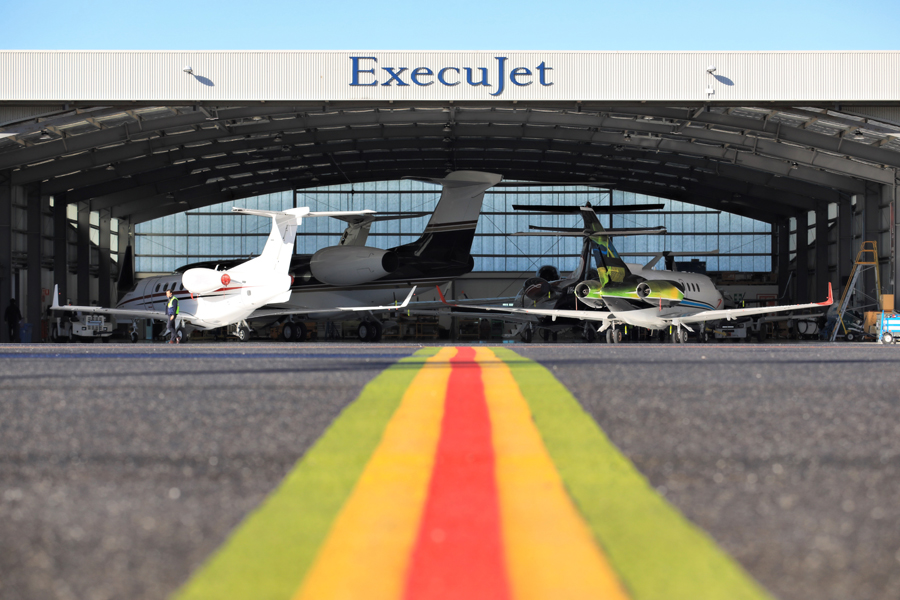10 Things You Can Do With Your Aircraft to Make the Most of the Downtime

By Richard Porter
Restrictions on air travel, as part of efforts to contain COVID-19, has meant some aircraft are grounded. But there are things that we can do to keep our aircraft in top condition and ready to fly again.
We spoke to our team of experts within our continuing airworthiness management organisation (CAMO) and came up with these tips. When it comes to aircraft maintenance, always refer to the aircraft and engine manufacturer’s procedures specific to your aircraft type – as each aircraft type is different – but here are some general points on what you can do to make the most of the current situation.
1. Start your engines
The engine is the most valuable system on the aircraft, so to maintain the value of your aircraft it is crucial to maintain your engines. Having an aircraft engine idle is never good. The engine will deteriorate unless proper storage measures are taken. For example, engine parts need to remain well-oiled otherwise internal components can corrode. Engine manufacturers will prescribe the frequency that engines should be operated based on the environment the aircraft is being stored in. Failure to adhere to the engine manufacturer’s recommendation may cause you to inadvertently fail to comply with terms set out in warranties, maintenance service plans or insurance policies. Therefore, it is very important to start those engines at least every 30 days and let the oil in the engines come up to temperature.
2. Check your fuel tanks
If the aircraft is on the ground for a long time, the fuel tanks can suffer from water contamination caused by condensation or, worse, a contaminated fuel source. It is recommended to drain the water from the fuel tanks every seven days.
Once the water is drained, inspect the fuel for smell and clarity and do a contamination detection test. Microbiological organisms growing in the fuel tanks and fuel lines, if left undetected, will be detrimental to aircraft systems.
A preventative approach to microbiological contamination is highly recommended. Even in the event that the contamination test results are negative, it is still recommended to proceed with an anti-fungal treatment at a low dosage to mitigate microbial growth. Many operators choose to do this, especially if their aircraft is located in a tropical region with high humidity.
If the result of the contamination detection test is positive, then you need to speak to the original equipment maker (OEM) and maintenance, repair and overhaul (MRO) company to determine the most effective method to completely eradicate the infestation. This will often require entry to the fuel tanks, physically removing the growth and using an anti-fungal treatment at a “shock” level to eliminate spores.
3. Check that the flight control surfaces are moving correctly
Ensuring that all primary and secondary flight control surfaces are operating and functioning correctly is vital prior to start of the daily operation so why would you skip it while the aircraft is parked on the ground? During the engine runs is the perfect time to operate these systems and identify any defects and rectify these before operations restart.
4. Do landing gear ‘swings’
The aircraft’s landing gear is an incredibly sophisticated and complex piece of equipment that needs to withstand the impact and full force of the aircraft landing. As is the case with engines, landing gears deteriorate when left idle. For aircraft on the ground, for extended periods of time, we recommend doing ‘landing gear swings’ – extending and retracting the landing gear. To perform that, we need to jack up the aircraft, so the wheels are clear of the ground. But it is well worth it, as a well-maintained landing gear will help protect the residual value of your aircraft.
5. Turn on the avionics and environmental control systems
It is also a good idea to turn on these systems as well to make sure they are working well during the engine runs.
6. Update the log books
The mainstream news media, in their coverage of COVID-19, are writing a lot about the importance of ‘traceability’ and ‘track-ability’ in helping to contain the virus. Well, ‘traceability’ and ‘track-ability’ are concepts that we are very familiar with in the aircraft MRO industry. Every part that is installed on an aircraft has a unique number, that is traceable, and needs to be recorded in the log book. Any work done on the aircraft needs to be recorded in the aircraft’s log books. Every run, including ground runs, also needs to be recorded in the log books. Now is a good time to make sure the log books are up to date, because when it comes time to trade-in your aircraft, those log books are going to be scrutinized by potential buyers. Incomplete log books adversely affects the sale price of your aircraft. Aircraft buyers are also going to be looking very closely at the logbooks to see that the aircraft was well maintained and not kept idle during the 2020 pandemic.
7. Do the upgrade work
Aircraft upgrades, such as installing a new avionics system or new cabin interiors, are often bundled with scheduled heavy maintenance checks, so as to reduce the downtime. But now that there is no getting away from the downtime, best to do the aircraft upgrades now. The added benefit of doing upgrade work now, is your aircraft will be in the hangar, so you save money on aircraft storage and know your aircraft is protected from the elements.
8. Care For The Aircraft’s Exterior
Taking care of your aircraft’s exterior is very important. This includes routine tasks such as installing the covers and pins, to prevent moisture and insects or animals from getting in; and washing and polishing the airframe and surrounding areas. Having the aircraft in a hangar is the best way to protect it from the elements. But if the aircraft must be parked outside, we recommend doing a full aircraft wash. This will remove debris and particles from the surface, helping to prolong the life of the paint work.
For longer airframe protection and longevity, we recommend applying a polymer – such as Teflon or Permagard – and polishing it to create a nice protective layer. Protecting the aluminium polished surfaces – such as the wings’ leading edges – is also very important. Protection with a polymer compound and subsequent polishing, increases the longevity of the surface and also makes your aircraft look good.
9. Detail your interior cabin
Now is the time to really make your aircraft interior feel like new by doing all the time-consuming detailing work – shampooing the carpets, getting the grey out of the seats, etc. Take the time to do the deep cleaning. Also, get rid of the built-in grime that can accumulate, over the years, on the pilot’s yoke, levers and switches in the cockpit.
10. Develop your knowledge base
This is a good time to read maintenance manuals. Take the time to do some in-depth reading and complete online courses you have been meaning to do, but never got around to doing. There are also webinars that you can sign up for that are free. These are usually organized by business aviation media organisations and relevant industry associations.
Richard Porter is the Business Development Manager Asia Pacific for ExecuJet MRO Services Australia

